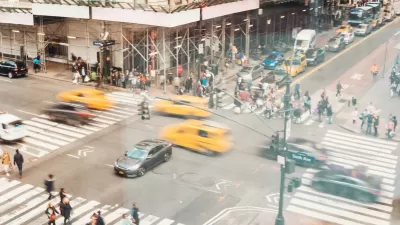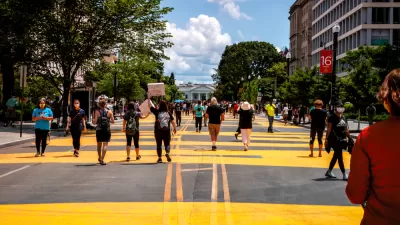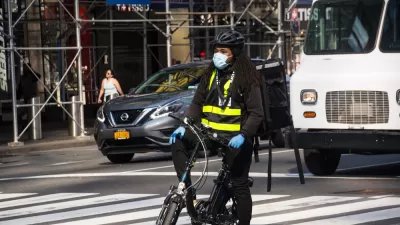Vision Zero pledges in New York City and Washington, D.C. have failed to slow the carnage on streets and roads—traffic fatalities are only increasing. It's time to start over.

Gersh Kuntzman shares the findings of a new report by Transportation Alternatives that analyzes traffic fatality data for New York City.
"Last month was the deadliest April since Mayor de Blasio took office in 2014 — and 2021, his last year in office, is on track to be the second deadliest year for road violence of his tenure, despite seven-plus years after the city officially adopted the Vision Zero initiative," writes Kuntzman to summarize the report's most topical findings.
Kuntzman shares more specifics, among others listed in the article:
- "Through April 30, 70 New Yorkers were killed in traffic violence — the deadliest start of any year since 2014 (when there were 72 fatalities)."
- "The pedestrian death toll is staggering: 43 pedestrians have been killed so far this year — the deadliest first four months for walkers of any year since Mayor de Blasio took office."
With statistics like that, the narrative about the success of Vision Zero in New York City has clearly changed since Mayor de Blasio touted the program's success on Queens Boulevard in Brooklyn, once known as the Boulevard of Death, in 2017.
Kuntzman also notes the prescriptions for traffic fatality reductions included in the Transportation Alternatives report, including fast tracking design improvements like those on Queens Boulevard in other parts of the city, creating more car-free spaces, and funding the city's Streets Master Plan, among other suggestions.
Reevaluating and reformulating Vision Zero is also the focus of a recent series of posts by Conor Shaw and Nick Sementelli for Greater Greater Washington, which offers solutions for Washington, D.C.'s Vision Zero program "after six years of failure."
People of every age, from all walks of life, using any form of transportation are more vulnerable today than they were when Mayor Bowser launched Vision Zero six years ago. When the campaign was announced, DC had experienced 26 fatalities on our streets the previous year. The Mayor was unambiguously clear in her goal: these deaths were unacceptable and, more importantly, preventable. “By 2024 we will do everything in our power to eliminate transportation fatalities or serious injuries.”
The 2016 report set an explicit target. To get to zero deaths on schedule, the District needed to see a 35% reduction every year. But the reality is that DC is not making any progress. Instead, things have gotten steadily worse: 37 people were killed last year, a 40% increase over the 2015 baseline.
To get Vision Zero back on track, Shaw and Sementelli suggest following the success of other cities, like Oslo, in slowing down automobiles and adopting a strategies actually show to "protect lives, increase mobility, and achieve greater equity in transportation." More specifics are added in a separate, follow up post, including:
- Implementing emergency "road diets" by reducing lanes on all arterial streets
- Reducing speed limits on all roads
- Deploying automated speed enforcement
- Reappropriating street space for public transportation, walking, and micromobility
- Making safe transportation modes free and charging more for deadly forms of transportation
- Adding oversight for the work of the District Department of Transportation and the City Council toward Vision Zero goals.
A lot more detail on each of those prescriptions is available in the source article.
It is not delusional to work toward Vision Zero goals—even if it's hard to look around at the results of Vision Zero programs, such as they are, and not tend toward skepticism. The city of Hoboken has implemented major changes to its streets, for example, and earlier this year completed a third year without traffic fatalities. For more prescriptions for how to actually commit to ending traffic fatalities, see a Planetizen feature by Angie Schmitt.
FULL STORY: Vision Zero in Decline: New Stats Show Blood Tide of Road Violence is Unchecked

Alabama: Trump Terminates Settlements for Black Communities Harmed By Raw Sewage
Trump deemed the landmark civil rights agreement “illegal DEI and environmental justice policy.”

Planetizen Federal Action Tracker
A weekly monitor of how Trump’s orders and actions are impacting planners and planning in America.

The 120 Year Old Tiny Home Villages That Sheltered San Francisco’s Earthquake Refugees
More than a century ago, San Francisco mobilized to house thousands of residents displaced by the 1906 earthquake. Could their strategy offer a model for the present?

In Both Crashes and Crime, Public Transportation is Far Safer than Driving
Contrary to popular assumptions, public transportation has far lower crash and crime rates than automobile travel. For safer communities, improve and encourage transit travel.

Report: Zoning Reforms Should Complement Nashville’s Ambitious Transit Plan
Without reform, restrictive zoning codes will limit the impact of the city’s planned transit expansion and could exclude some of the residents who depend on transit the most.

Judge Orders Release of Frozen IRA, IIJA Funding
The decision is a victory for environmental groups who charged that freezing funds for critical infrastructure and disaster response programs caused “real and irreparable harm” to communities.
Urban Design for Planners 1: Software Tools
This six-course series explores essential urban design concepts using open source software and equips planners with the tools they need to participate fully in the urban design process.
Planning for Universal Design
Learn the tools for implementing Universal Design in planning regulations.
Clanton & Associates, Inc.
Jessamine County Fiscal Court
Institute for Housing and Urban Development Studies (IHS)
City of Grandview
Harvard GSD Executive Education
Toledo-Lucas County Plan Commissions
Salt Lake City
NYU Wagner Graduate School of Public Service





























